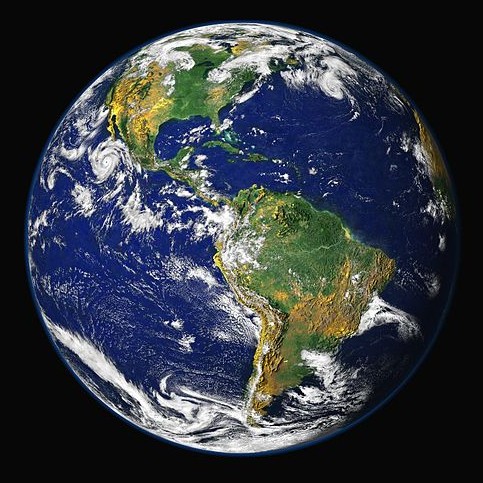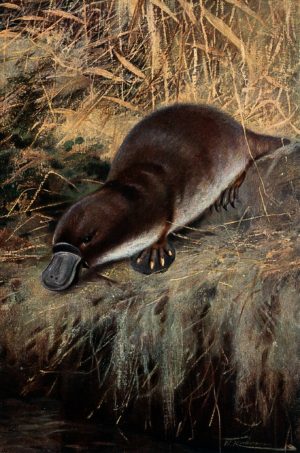Mammals Cannot Evolve Fast Enough to Escape Extinction Crisis
Nature’s defence mechanism, evolution, cannot keep up with the extermination of species by humans. If conservation efforts are not improved, so many mammal species will go extinct in the next five decades that nature will need 3-5 million years to recover.
 Image: By NASA/ GSFC/ NOAA/ USGS [Public domain]
Image: By NASA/ GSFC/ NOAA/ USGS [Public domain] We humans are exterminating animal and plant species so quickly that nature’s built-in defence mechanism, evolution, cannot keep up. A team of researchers has calculated that if current conservation efforts are not improved, so many mammal species will become extinct during the next five decades that nature will need 3-5 million years to recover.
There have been five upheavals over the past 450 million years when the environment on our planet has changed so dramatically that the majority of Earth’s plant and animal species became extinct. The last mass extinction event was caused by a giant asteroid impact on Mexico, just after large volcanic eruptions in what is now India, and saw the end of the dinosaurs and ammonites. After each mass extinction, evolution has slowly filled in the gaps with new species. Mammals took advantage of the last extinction event but now just one species, Homo sapiens, has come to so dominate other species that it is causing the next mass extinction. For the first time, it is not caused by natural disasters, it is being caused by us.
Overpopulation and overconsumption by humans is the reason why we are in the midst of the sixth mass extinction event. Scientists have described a “biological annihilation” of wildlife in recent decades, as species populations fall and their habitat shrinks. Billions of populations of mammals, birds, reptiles and amphibians have been lost all over the planet. Extinctions are occurring at a much faster rate than the natural ‘background’ rate of extinction, and researchers from Aarhus University and the University of Gothenburg have calculated that the extinctions are moving too rapidly for evolution to keep up.
If mammals diversify at their normal rates, it will still take them 5-7 million years to restore biodiversity to its level before modern humans evolved, and 3-5 million years just to reach current biodiversity levels, according to the analysis, which was published recently in the scientific journal PNAS (Proceedings of the National Academy of Sciences of the United States of America).
The researchers used their extensive database of mammals, which includes not only species that still exist, but also the hundreds of species that lived in the recent past and became extinct as Homo sapiens spread across the globe. This meant that the researchers could study the full impact of our species on other mammals.
However, not all species have the same significance. Some extinct animals, such as the Australian leopard-like marsupial lion Thylacoleo, or the strange South American Macrauchenia (imagine a lama with an elephant trunk) were evolutionary distinct lineages and had only few close relatives. When these animals became extinct, they took whole branches of the evolutionary tree of life with them. We not only lost these species, we also lost the unique ecological functions and the millions of years of evolutionary history they represented.
Palaeontologist Matt Davis from Aarhus University led the study. He said: “Large mammals, or megafauna, such as giant sloths and sabre-toothed tigers, which became extinct about 10,000 years ago, were highly evolutionarily distinct. Since they had few close relatives, their extinctions meant that entire branches of Earth’s evolutionary tree were chopped off. There are hundreds of species of shrew, so they can weather a few extinctions. There were only four species of sabre-toothed tiger; they all went extinct.”
Regenerating 2.5 billion years of evolutionary history is hard enough, but today’s mammals are also facing increasing rates of extinction. Critically endangered species such as the black rhino are at high risk of becoming extinct within the next 50 years. Asian elephants, one of only two surviving species of a once mighty mammalian order that included mammoths and mastodons, have less than a 33% chance of surviving past this century. The iconic lion was historically distributed over most of Africa, southern Europe, and the Middle East, all the way to northwestern India, but now the vast majority of lion populations are gone. Even common species are in decline, all of which threatens civilisation because we depend so heavily on the ecosystem services that other species provide, such as crop pollination, flood defences, providing food from the sea and maintaining a liveable climate.
The researchers incorporated expected extinctions in their calculations of lost evolutionary history and asked themselves a question: Can existing mammals naturally regenerate this lost biodiversity?
Using powerful computers, advanced evolutionary simulations and comprehensive data about evolutionary relationships and body sizes of existing and extinct mammals, the researchers were able to quantify how much evolutionary time would be lost from past and potential future extinctions as well as how long recovery would take.
The researchers came up with a best-case scenario of the future, where humans have stopped destroying habitats and eradicating species, reducing extinction rates to the low background levels seen in fossils. However, even with this overly optimistic scenario, it will take mammals 3-5 million years just to diversify enough to regenerate the branches of the evolutionary tree that they are expected to lose over the next 50 years. It will take more than 5 million years to regenerate what was lost from giant Ice Age species.
“Although we once lived in a world of giants: giant beavers, giant armadillos, giant deer, etc., we now live in a world that is becoming increasingly impoverished of large wild mammalian species. The few remaining giants, such as rhinos and elephants, are in danger of being wiped out very rapidly,” says Professor Jens-Christian Svenning from Aarhus University, who heads a large research program on megafauna, including this study.
Nevertheless, the research team does not just have bad news. Their data and methods could be used to quickly identify endangered, evolutionarily distinct species, so that we can prioritise conservation efforts, and focus on avoiding the most serious extinctions.
As Matt Davis says: “It is much easier to save biodiversity now than to re-evolve it later.”





No comments yet.